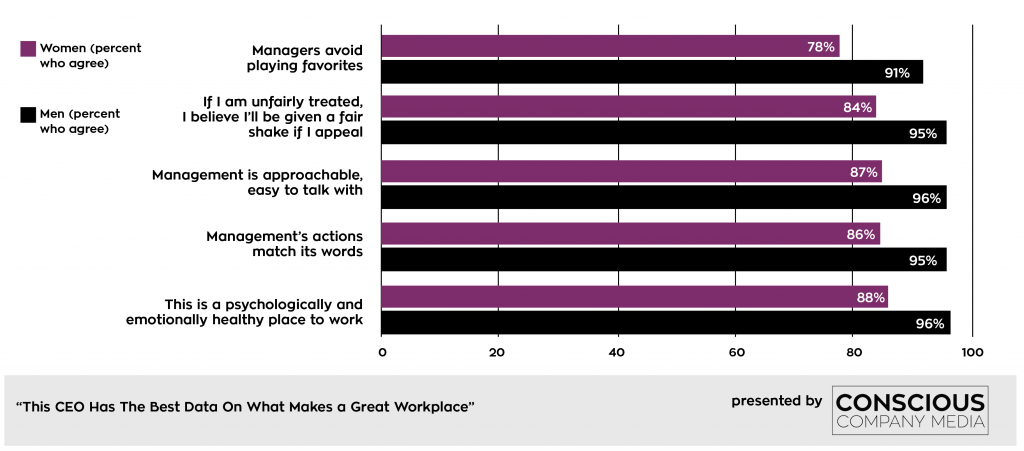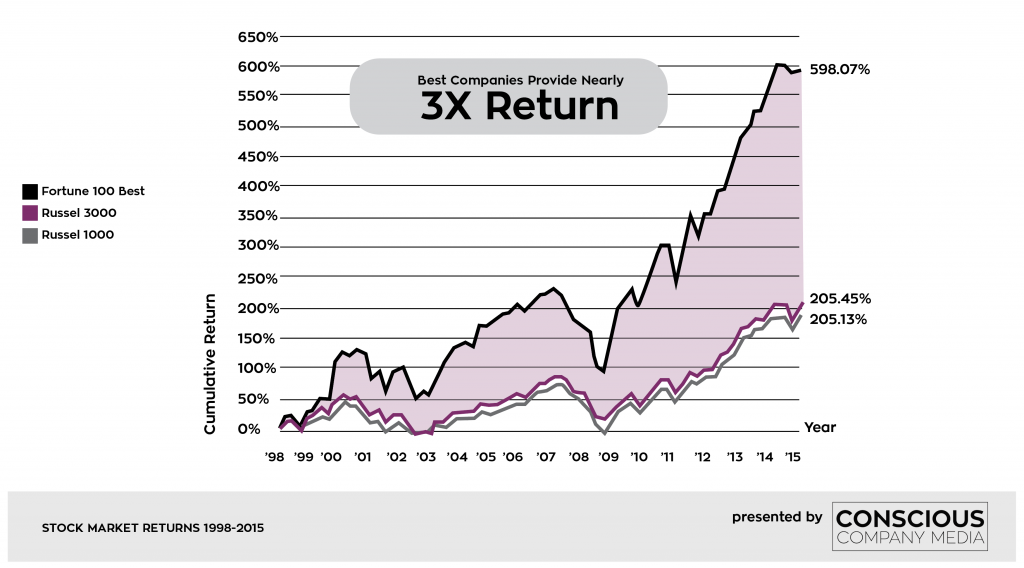What really makes a great place to work? That’s the question the Great Place to Work Institute (GPTW) has been researching for more than two decades. Most publicly, the San Francisco- based consulting and research rm’s annual global survey provides the data behind Fortune magazine’s long-running “100 Best Companies to Work For” list, but its mission goes way beyond merely celebrating the most successful or innovative companies. “We are building a better society by helping organizations transform their workplaces for all,” explains Michael Bush, GPTW’s CEO. “That’s why we do what we do.”After years of researching what makes a company good to work for, journalist Robert Levering founded GPTW in 1991, and the organization has since surveyed more than 100 million employees at tens of thousands of firms around the world via its offices in 44 countries. The end result is a surprisingly simple formula for creating a great place to work. “We’re trust experts,” explains Bush. “We help by measuring the trust level within organizations, and then we provide precise, focused actions to improve that trust level.”
An engineer by training, Bush spent 30 years leading various businesses before taking over as GPTW’s CEO in 2015. Under his influence, the company recently added the words “for all” to the end of its mission statement, a subtle change that signals an important shift in the way GPTW will evaluate companies and create its rankings starting with the 2018 list. After looking at differences in survey results for the top 100 companies across gender, ethnicity, age, and hourly vs. salary lines, Bush “found you could be a ‘Great Place to Work’ and have people who were having a not-great experience,” he told the 2016 Conscious Capitalism CEO Summit. “I didn’t think that was ok. That’s why I added the ‘for all.’ For the 2018 list, we’re going to measure disparity. We’re going to be sure it’s a great place to work for all. You’re not going to get the label just because a group of people are having a great time.”
We spoke with Bush about what GPTW has learned over the years about workplace culture, what his time there has taught him about values-based leadership, and why the conscious business movement needs to take a hard look at the types of faces that appear in top leadership roles if it hopes to drive the kind of systemic societal change it envisions.
The Interview
So, what makes a great place to work?
Michael Bush: The root of the tree is trust. You can’t have engaged employees if they don’t feel trusted. The key to a person feeling trusted is that they are treated with respect, they feel their leaders are credible, and they’re treated fairly. That’s what our research has shown us.
Do people get thanked for the work that they do? Do people feel that they’re cared for as human beings, and not just employees? Do people feel that when they speak, people listen, and they can see some of the results of things they’ve said in the decisions management makes? Are people asked for their opinions, so when they speak it matters? Are people developed as people so they’re being encouraged to give their personal best? Do people feel a sense of camaraderie, that they’re a part of something larger than themselves, and therefore take great pride in the work that they do because they know it matters?
The way those things show up is that people are inspired by the work they do and the people they work for and with. They can be themselves, which is what camaraderie is all about, and be a part of a caring group. Then, as a result, they take great pride in the work they do, and they’re willing to give extra to get the job done. That’s vital for innovation, where people not only have to do their work, but they also have to think about how to do it better, how to do it faster, or how to create something brand-new. For us, it all comes down to trust.
Is that answer — trust — universal?
MB: It is. It crosses all industries. We have the data to prove it. And not only that, to be a great place to work in San Francisco takes the same thing as to be a great place to work in Bogotá, Columbia. I can prove it, because we do surveys in Bogotá, Columbia.
While people will say industries are different, technology sectors are different, nations are different — in terms of trust, it’s all the same. You can have a person making $150,000 a year who does not feel trusted in their job, and therefore, it’s not a great place to work. You can have a person making $15,000 a year in a country outside the United States who feels the place they work is a great place to work. And they say that because of respect, credibility, and fairness — not because of pay.
What trends are you noticing around the idea of culture in the workplace?
MB: “Culture” was the word of the year in the Merriam-Webster dictionary in 2014, so something has definitely happened. It’s something that people globally are talking about more often. Another popular term that has evolved over the last few years is “engagement.” It’s something people are measuring actively around the world, trying to see how connected people really are to the place where they work. Net Promoter Score is a fast-growing popular metric which is basically asking employees very, very frequently what their work experience is like and whether they’d recommend the place that they work to someone else. Underneath both of those is trust. We’ve shown the correlation that trust is the best predictive analytic metric for how you’re going to do in Net Promoter Score and engagement.
In terms of trends, the idea of a once-a-year survey is being replaced with people wanting to provide feedback more frequently. Over the last few years, people want to be able to say how they’re feeling about their work experience whenever they want to say it — it’s fueling Glassdoor. GPTW is developing tools to make gathering feedback from employees happen in a way that’s more frequent and less cumbersome, and done from a mobile device.
I’d say the final thing, based on the Millennial generation, is that people expect to see change promptly after providing feedback. Other groups, say Gen Y or Baby Boomers, have developed more patience for how long it will take an organization to change. Millennials are saying, “Look, we’ve given you the feedback and we expect things to change now.” It means leaders have to be far more responsive to feedback.
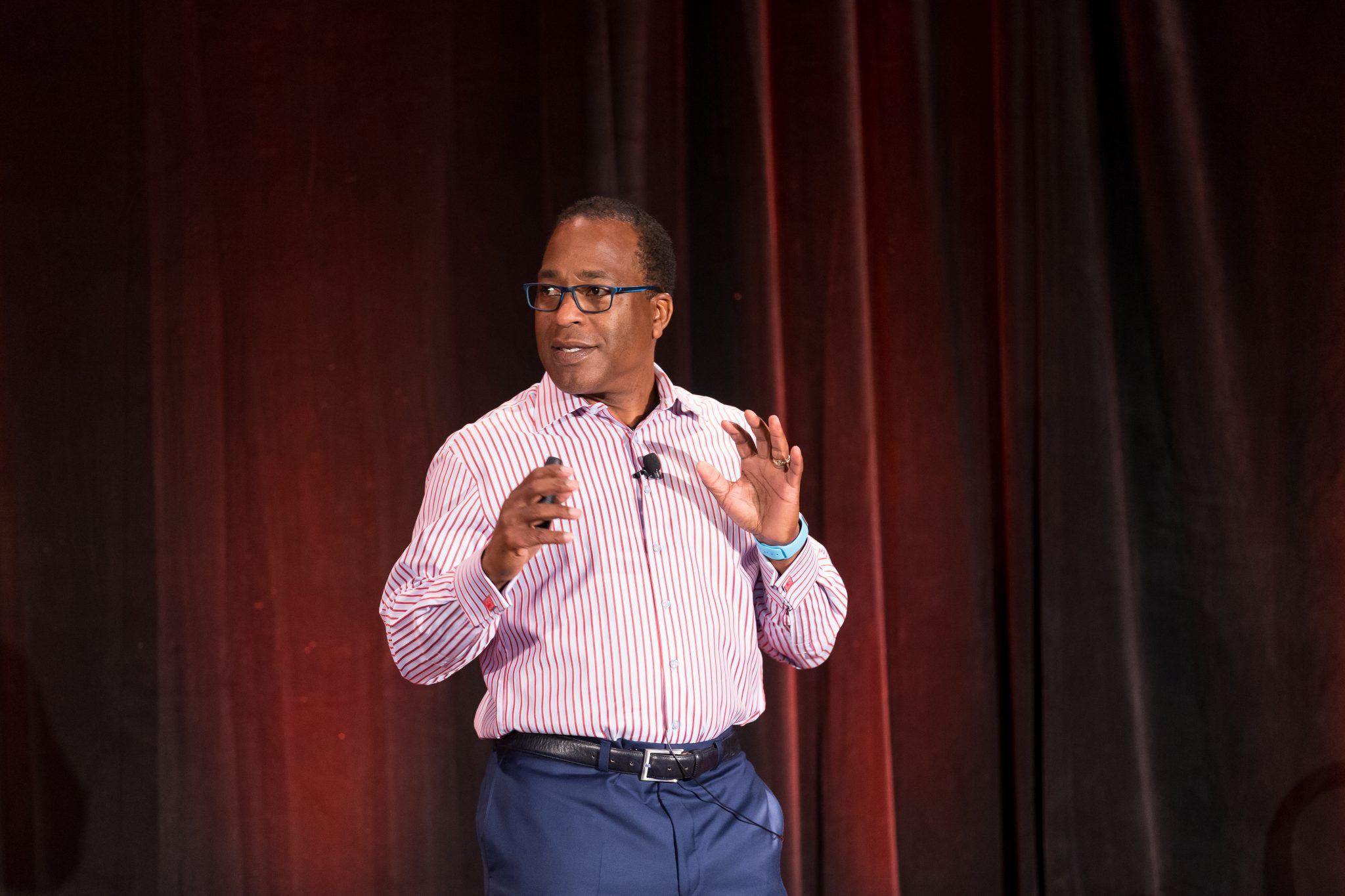
A leader’s role is to support employees through change, Bush says.
What common myths, mistakes, or misunderstandings do you encounter about being a great place to work?
MB: The first misconception is probably the three Ps: that a great place to work is about perks, programs, and pay. That’s not true. I’m not saying those things aren’t important, but they are definitely not the reasons that people say a place is a great place to work. The perks never come up for employees when they’re talking about what they love about where they work. They talk more about the respect, which is being given challenging work; being trusted with that work; being asked for their opinion and that they can see that their opinion matters; being treated fairly; given flexibility; and being treated like a fully formed adult. They talk about those things. They don’t talk about free lunches and pingpong tables. But those perks are the things that the media writes about most often. That leads to a misperception that those things affect whether a place is a great place to work or not.
The second myth is that you can’t measure culture — you can’t measure trust. That’s just a misunderstanding.
The third is that only big companies can do it, which is not true. We have people on our “100 Best” list with as few as 1,200 employees. People, by thinking that only big companies can do it — they miss out on improving their business based on getting input from their employees. And they think that it’s expensive. Creating a high-trust culture is not expensive. That’s the beauty of it.
From your point of view, how does this idea of culture relate to what people call “management”?
MB: Leadership has a responsibility to manage the culture. By managing it, I mean you’ve got to measure it. Then you have to have an action plan to improve it, and you have to hold people accountable, just like every other part of the business. Sometimes people look at culture as an HR thing that’s mushy. That’s totally the wrong way to look at it. It’s just like a product launch, a production line, or any other aspect of your business. You have to measure it, and then you have to take action and measure which actions are giving you the results you want. That’s up to leaders.
How has your personal understanding of workplace culture evolved over the years?
MB: Through most of my business career I thought there were leaders who were good at creating what I would call a great place to work. They were “different” leaders, and they had the ability to do that. It’s like the flaw of thinking you either have charisma or you don’t; “the high-trust leader — you either are that or you’re not.” That’s not true.
There are some natural leaders who are great at it, but we have done the research to understand what creates that, and we help create a situation where any leader can improve. When a leader improves — let’s say a leader who does not naturally thank or recognize people, when that leader begins to do that — it’s like dropping a boulder in a pond. That’s the ripple effect. Because people see the change, they feel the change, and then they start to change.
We’re always asking employees to do more, but they’re only going to be inspired to do it if they see leaders are changing. It’s really a bunch of inside jobs. It’s more enjoyable to work with people who are changing, and then all of a sudden, “My leaders seem to be more thoughtful and more open to my innovative ideas, and they seem to want to help me develop and grow. And they’re sending me signals that regardless of who I am or what I believe in, I too can get to the top of this organization, provided that I work hard and I do a good job,” which is sending a signal of respect. When leaders make minor adjustments in the way that they treat others, communicate to others, and listen to others, they get huge results.
Some people naturally like what I’m saying right now, but there are others who say, “I need quantitative information. This is too touchy-feely for me.” Well, we have that. That’s the beauty of it. We’ve done the research on great companies versus not-great companies; we’ve compared profitabilities, stock market performance, attrition numbers, products getting to market, quality, reliability. We’ve done all the work so that we can win on the “It’s good to treat people great” plane, and we can win on the “Show me the facts and the path to profitability, and why if I treat people great, I’m going to have a more profitable business.”
We published a study recently where we showed that on the metric of diversity, great companies’ revenue grew at a 24 percent higher rate. It was a huge finding done by an outside agency that just took the companies that had passed the “Great Place to Work” threshold versus companies in their industry sectors and compared revenue growth; they found 24 percent more revenue growth from companies that are Great Places to Work.
We also just did a study with HIP Investor which analyzed small, medium, and large Great Places to Work companies that are publicly traded and compared their stock market returns over the past 15 years versus companies that are not on our list. The companies on our list outperformed those not on the list on the S&P by a factor of three, which is huge. It means if you invested $100,000 eleven years ago in an S&P 500, you’d have $200,000 today; if you’d invested in Great Place to Work companies, you’d have $400,000 today. We have that data.
What changes to your own leadership toolbox or style, if any, have you made since coming to Great Place to Work and starting to absorb the lessons from all this data?
MB: In my business career, I’ve always tried to run the business in a way that our people would say, “This is the best job I’ve ever had,” and that our customers would say, “You delivered the best service we’ve ever had.” So, you’re always guided by those two things. Then you’re moving through your life making tradeoff decisions every day to try and make those two things happen.
Since being at Great Place to Work, I think about the people part all the time, and I realize that the people part is what gets you the customer service part. Really, the thing to be thinking about is “What do I need to be doing as a leader to make the employee experience better?” It’s a lot more than I ever was consciously aware of.
I know that the number one thing business leaders need to be doing right now is a better job of supporting employees through change. Change is rampant, the pace of it is nonstop, and people need support through it. It doesn’t just happen because you want it to happen. Culture work is the answer, and the top leadership team is there to provide the solution.
Often, leaders don’t want to do this because they’re more comfortable doing profit and loss analysis, product launches, innovation, entering new markets, or looking at new ways of selling. Those things are more comfortable because it fits our personality, and probably is the reason we got in the job. The problem is, none of those things make employees feel supported through change. And when employees don’t feel supported through the change, they start to loosen their connection to the business, they start to slow down. It looks like resistance. It’s not. They need communication more frequently, and in a very candid way, like a teacher would explain to a student, so they can connect the dots and understand why leadership is doing certain things.
It takes conscious work. Leaders say they want to do a bunch of things — they want to run a great company, hit profit targets, grow the business, increase the value of the business. You can see a leader get an award for great growth or market dominance, but when you see a leader get an award their people feel, you see the leader become a human being, which is what I believe they’re all after, including myself. I get to see it all the time. I fly around the world watching people get awards from our list, and you see that that’s what they were searching for all along, but they didn’t know it.
There’s a self-actualization thing that happens as a result of this work, but it doesn’t happen by accident — it takes conscious work and a plan for how you’re going to work in a way that supports people through the changes. You also get the benefit of people being innovative, you get products to market faster, you can do fewer offsite meetings working on communication. The place is just lined up.
I’ve run businesses through my whole career, and now I’m in a field that has been driven by human resource professionals, but I’m a business person, so I’m always thinking from the leadership point of view. But I am saying the same thing that the human resource professionals said, which is that people matter. Boy, do they really matter. And now I get it. They really matter. It’s made me a much better leader, and a much better communicator to other CEOs about the steps they need to take. Not their HR person, not their diversity person: the steps they need to take to create an environment where people feel supported through the change.
What, on a day-to-day basis, does supporting employees through change actually look like?
MB: You have to do more education and development. You have to bring your whole company along so that they understand how to run the business like it’s theirs. You have to be frequently educating and getting everybody on the same page about why the business is doing what it’s doing. It’s really a back-to-basics movement. Leaders assume people know. People don’t. They’ve been hired, they do a task, and they start working a ton of hours on that task. They really don’t understand why they’re doing it in terms of purpose or business strategy.
You have to have frequent communications letting people know that this is why we’re launching this product, here’s what it does, and why. This is what it’s going to do for the customer, and the market opportunities. You should have your people having an experience once a month where they’re getting an education and getting developed at the same time about the basic parts of the business. That’s a way of supporting people through the change. You don’t have one group that gets it and one group that doesn’t. You’re bringing everybody along, and that’s how you let them know you care about all of them. That’s a conscious act, a conscious decision, and you need to follow up on it.
A lot of the best companies have a practice of having workgroups of people coming together with the role of connecting leaders to employees — we call ours the People Posse. They let leadership know what’s going on with employees and let employees know what’s going on with leaders. And a great place to work isn’t just the leaders’ responsibility. Every employee has that responsibility. You can’t just have leaders working on respecting employees, you’ve got to have it both ways.
How do you see or understand the relationship between being a great place to work in all these ways we’ve been talking about and other forms of stakeholder responsibility or sustainability or corporate stewardship?
MB: If we are conscious, it means by definition that “we’re awake, we’re aware, and we’re sensitive to things.” If you’re awake and aware and sensitive to things, you know that profit alone is not being conscious. That’s being unconscious. You’re not aware and awake to know the role your people play in making that happen, the role your community plays in making that happen, and for sustainability, the impact you have on the environment and its role in making that happen. For people to really care and give themselves 100 percent, it has to be about all the things that people see and experience and are sensitive to.
Being a great place to work — because people are involved — often gets put on the HR bookshelf. That is unfortunate, because being a great place to work does involve the relationships people have with each other and the people they work for, but being a great place to work means you have a culture that fuels innovation. Otherwise, you’re going to have a great place to work that’s out of business in four years, and that’s not a great place to work. That was a great place to work.
Being a great place to work means that you’ve got long-term viability and sustainability, which means that you’ve got a business mindset, which means that you need a culture that loves new ideas, testing new ideas, experimenting, trying, listening — that a good idea can come from anybody regardless of their age, what they look like, their color, or their sexual orientation. We want them all, because the more, the merrier. There’ll be more needles in the haystack.
Our mission is building a better society by helping companies transform their workplaces in the way that people treat each other, because the way that you treat each other gets you more innovation, gets you more financial sustainability. Since I got involved, we added “for all” onto the end of our mission because there were great places to work on our list in the past that clearly weren’t great places to work for everybody. They were great places to work for some people, the dominant group. I added the “for all” for that reason, so that we’re sensitive to the whole sphere and not leaving anyone out.
TRUST INDEX SURVEY
When Bush analyzed survey results from some of the Fortune 100 Best Companies to Work For list, he found large disparities in the answers given to certain questions along gender lines as well as by ethnicity, age, and other dimensions. A sample of gender disparities from one anonymous company’s survey is below.
We have the data to prove that in any workplace, there are different work experiences based on age, gender, job classification, whether you’re getting paid a salary or hourly, and on color. These are facts. In the world’s best companies, these are facts. Having a workplace where men feel like it’s great and women feel like it’s less great, it’s bad business. Forget about fairness and what’s right, you’re wasting human potential. You’ve got a group of people who aren’t feeling the same about the workplace — they want to, but they don’t know if it’s wise to fully commit themselves. I am very aware of the wasted human potential that businesses can seize and increase their profitability.
What Great Place to Work is now bringing to the conscious companies and Conscious Capitalism movement is that “for all” piece. If you’re a conscious business, you need to look in the mirror, because what I see is that not all are sensitive, or super aware, or super awake, because the groups are dominated at the top by one group. That’s not conscious. There’s a ways to go, and I think “great place to work for all” can help that happen. That’s what we can add to it, because it’s absent today.
When you say “one group,” just to make it more explicit, do you mean white men?
MB: Yeah. I probably shouldn’t have to even imply it. All we have to do is look at head executive teams, at the audience in a gathering of CEOs, but most people just want to move onto the next subject.
When hearing a lot about Conscious Capitalism and seeing what I was seeing, I was like, “That’s not really conscious. How can I help people get conscious?” The movement can be accelerated by being conscious of this piece. More people will want to be a part of it when they see people who look like them at the top of conscious companies. If you’re talking about Conscious Capitalism and your executive team all looks the same, I’m not sure that’s super attractive, except to others who look the same.
If leaders are willing to look around the room and feel like perhaps they need to change some things, and that it’s possible to get a highly qualified, awesome team that’s more inclusive, that’s an opportunity. That’s something that will help transform society.
The Stats
The Business Case for Being a Great Place to Work
GPTW’s massive data archive has allowed the company to make a strong, evidence-based case that creating a high-trust culture isn’t just good for employees — it’s good for the bottom line. Here are three ways that shows up.
1. TALENT RETENTION
Employees who experience a great workplace are far more likely to want to remain at their organization for a long time — saving companies money and effort on recruiting and training while fostering the higher performance of stable teams.
“I WANT TO WORK HERE FOR A LONG TIME”
The graph below shows the percentage of employees who indicate the survey statement “I want to work here for a long time” is either “often true” or “almost always true.” Across generations, the employees agree with that statement up to between 7 and 25 times more often at companies that rank as “great places to work.”
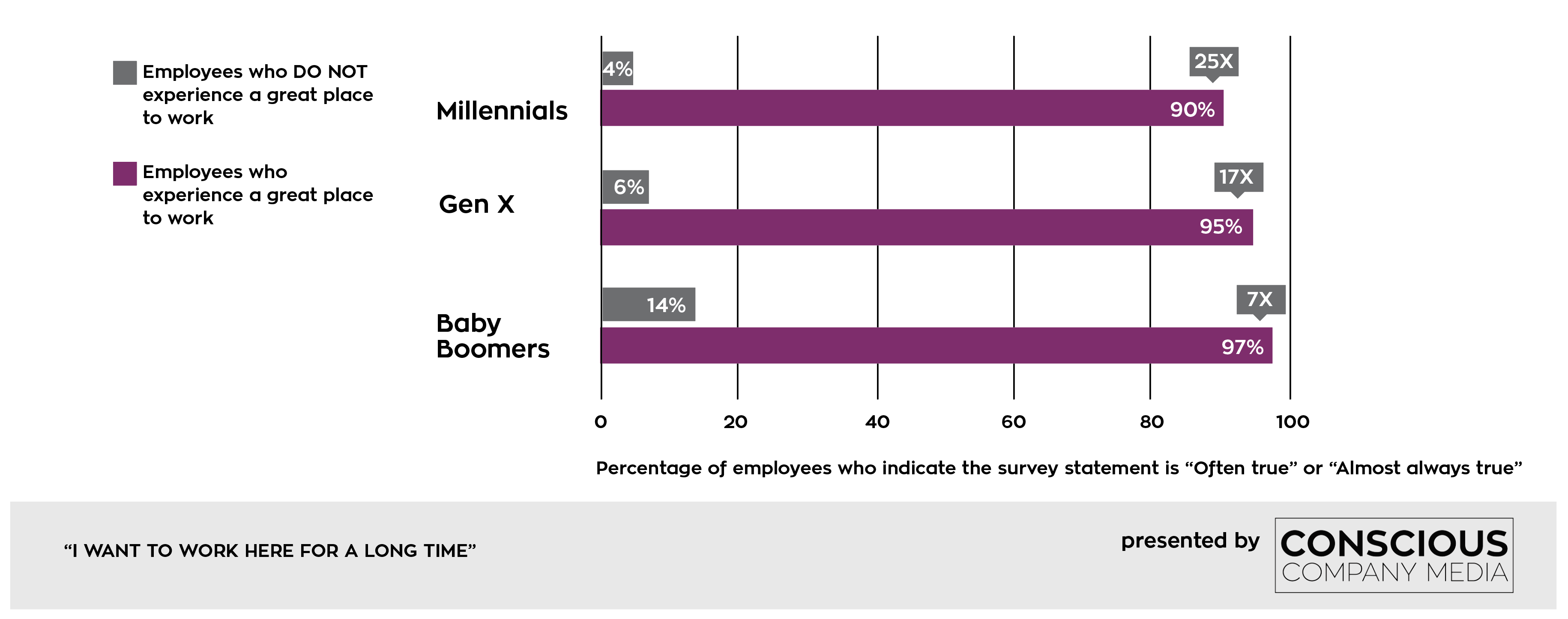
2. EMPLOYEE PRODUCTIVITY
When employees — no matter their generation — feel they are at a great workplace, they are more than 3 times more likely to report that their peers give extra to get the job done.
“PEOPLE ARE WILLING TO GIVE EXTRA TO GET THE JOB DONE”
The graph below shows the percentage of employees who indicate the survey statement “People are willing to give extra to get the job done” is either “often true” or “almost always true.” Across generations, the employees agree with that statement up to between 3 and 4 times more often at companies that rank as “great places to work.”
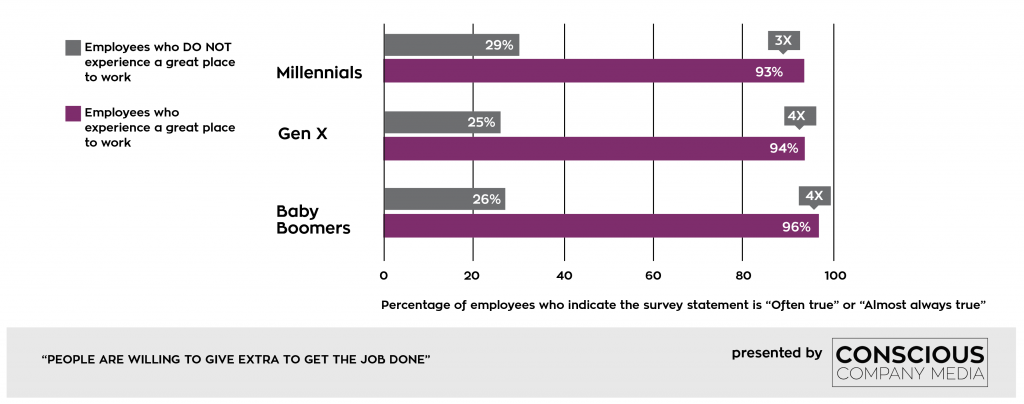
3. STOCK MARKET RETURNS 1998-2015
According to independent investment firm FTSE Russell, comparative cumulative stock market returns among the publicly held Fortune 100 Best Companies to Work For are nearly 3 times greater than the market average.
Charts adapted from “The Business Case for a High-Trust Culture,” by Great Place to Work, 2016

